Skin Cancer: Treatment Methods and Characteristics of Each Type
VerifiedAdded on 2023/06/15
|7
|1302
|62
Report
AI Summary
This report provides an overview of three main types of skin cancer: malignant melanoma, basal cell carcinoma, and squamous cell carcinoma. It details the characteristics of each cancer type, such as the ABCDEs of melanoma (asymmetry, irregular borders, color variations, diameter, and evolving nature), the reddish eruptions of basal cell carcinoma, and the scaly warts of squamous cell carcinoma. Furthermore, the report outlines the various treatment options available for each cancer, including surgical excisions, chemotherapy, immunotherapy, and radiation therapy. Specific treatment agents like temozolomide and 5-fluorouracil are mentioned, along with surgical techniques like Mohs surgery and cryosurgery, providing a comprehensive understanding of how these cancers are managed.

Running head: TREATMENT AND CHARACTERISTICS OF TYPES OF SKIN CANCER
Treatment and Characteristics of types of Skin Cancer
Name of the Student
Name of the University
Author Note
Treatment and Characteristics of types of Skin Cancer
Name of the Student
Name of the University
Author Note
Paraphrase This Document
Need a fresh take? Get an instant paraphrase of this document with our AI Paraphraser
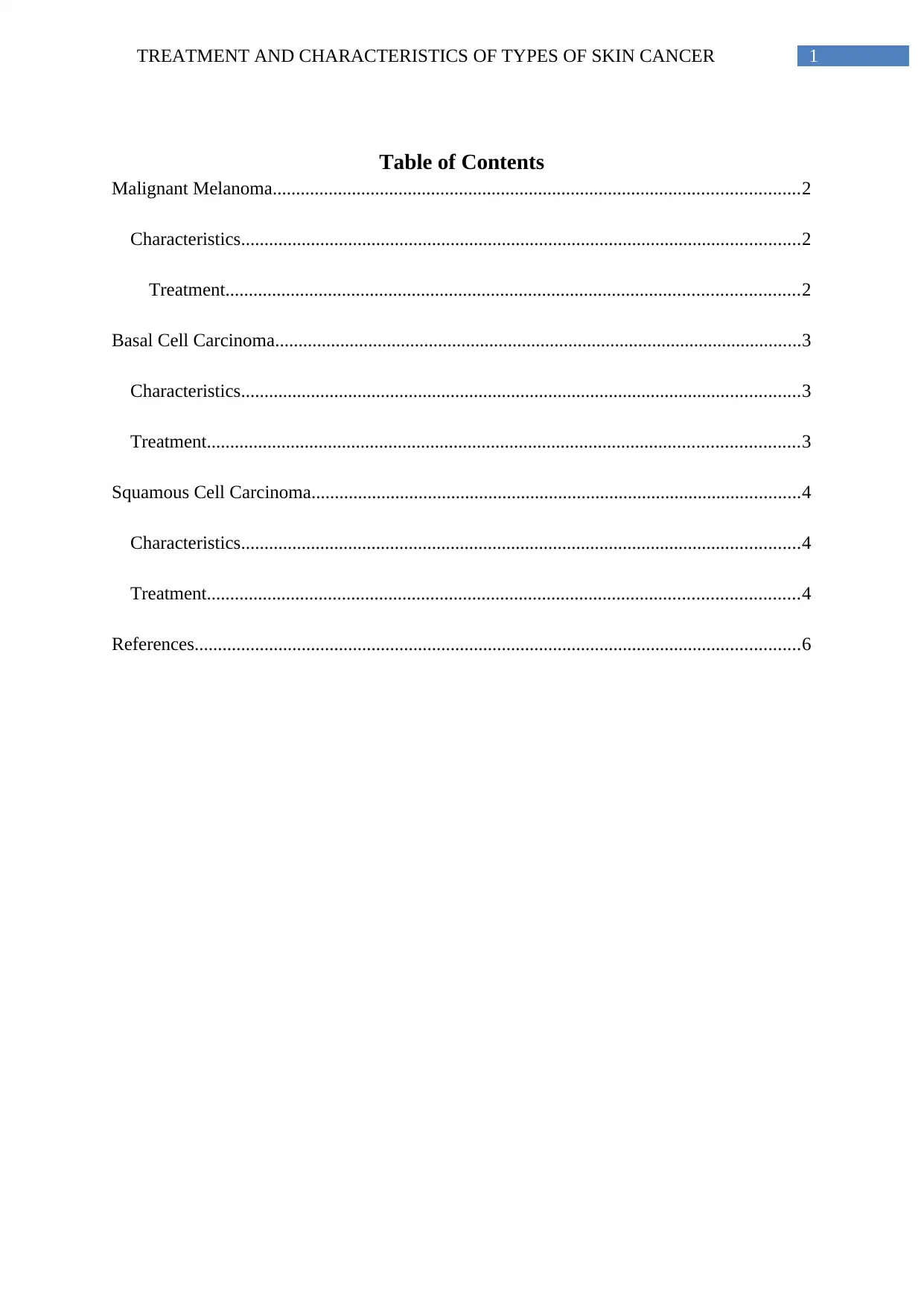
1TREATMENT AND CHARACTERISTICS OF TYPES OF SKIN CANCER
Table of Contents
Malignant Melanoma.................................................................................................................2
Characteristics........................................................................................................................2
Treatment...........................................................................................................................2
Basal Cell Carcinoma.................................................................................................................3
Characteristics........................................................................................................................3
Treatment...............................................................................................................................3
Squamous Cell Carcinoma.........................................................................................................4
Characteristics........................................................................................................................4
Treatment...............................................................................................................................4
References..................................................................................................................................6
Table of Contents
Malignant Melanoma.................................................................................................................2
Characteristics........................................................................................................................2
Treatment...........................................................................................................................2
Basal Cell Carcinoma.................................................................................................................3
Characteristics........................................................................................................................3
Treatment...............................................................................................................................3
Squamous Cell Carcinoma.........................................................................................................4
Characteristics........................................................................................................................4
Treatment...............................................................................................................................4
References..................................................................................................................................6
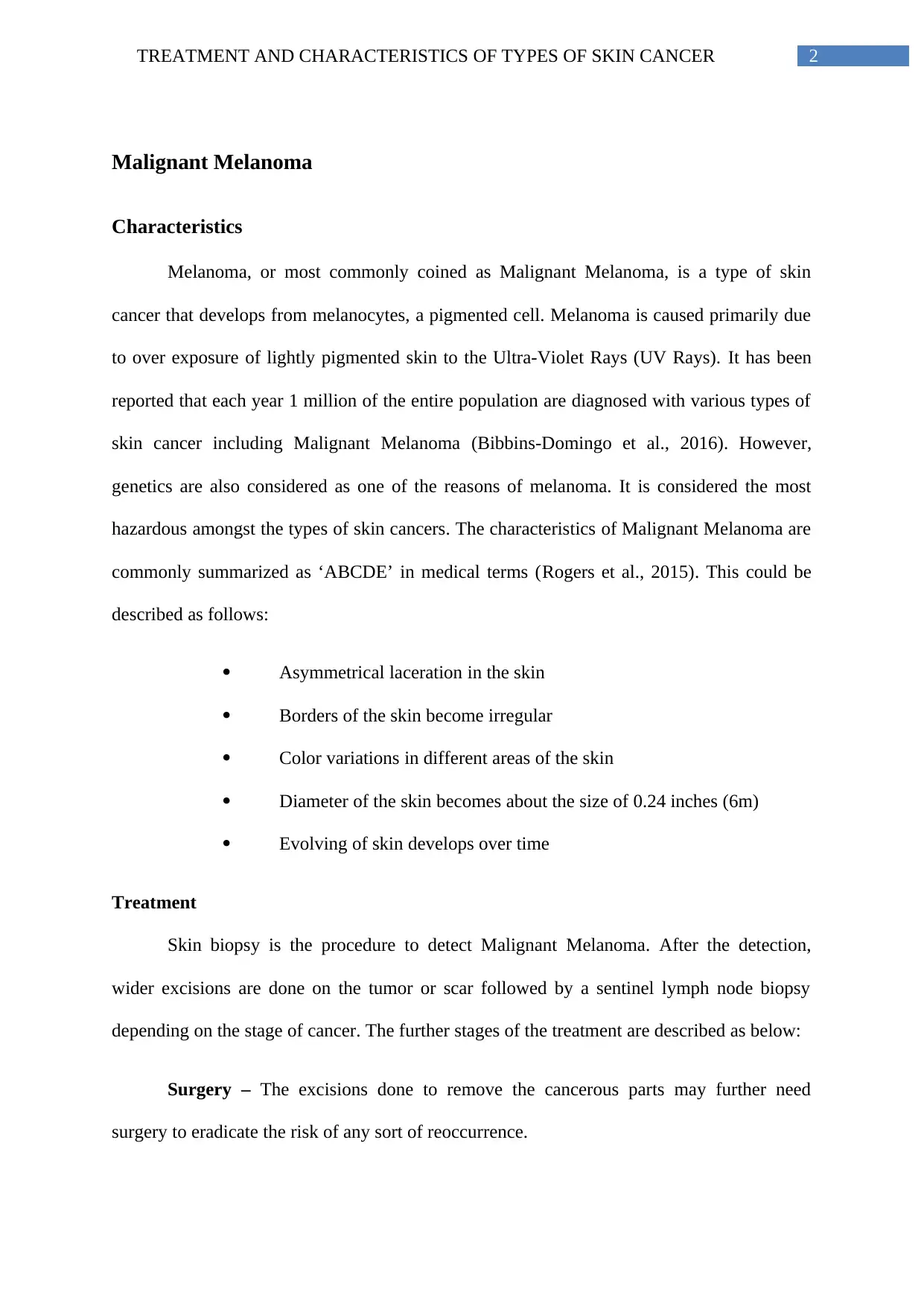
2TREATMENT AND CHARACTERISTICS OF TYPES OF SKIN CANCER
Malignant Melanoma
Characteristics
Melanoma, or most commonly coined as Malignant Melanoma, is a type of skin
cancer that develops from melanocytes, a pigmented cell. Melanoma is caused primarily due
to over exposure of lightly pigmented skin to the Ultra-Violet Rays (UV Rays). It has been
reported that each year 1 million of the entire population are diagnosed with various types of
skin cancer including Malignant Melanoma (Bibbins-Domingo et al., 2016). However,
genetics are also considered as one of the reasons of melanoma. It is considered the most
hazardous amongst the types of skin cancers. The characteristics of Malignant Melanoma are
commonly summarized as ‘ABCDE’ in medical terms (Rogers et al., 2015). This could be
described as follows:
Asymmetrical laceration in the skin
Borders of the skin become irregular
Color variations in different areas of the skin
Diameter of the skin becomes about the size of 0.24 inches (6m)
Evolving of skin develops over time
Treatment
Skin biopsy is the procedure to detect Malignant Melanoma. After the detection,
wider excisions are done on the tumor or scar followed by a sentinel lymph node biopsy
depending on the stage of cancer. The further stages of the treatment are described as below:
Surgery – The excisions done to remove the cancerous parts may further need
surgery to eradicate the risk of any sort of reoccurrence.
Malignant Melanoma
Characteristics
Melanoma, or most commonly coined as Malignant Melanoma, is a type of skin
cancer that develops from melanocytes, a pigmented cell. Melanoma is caused primarily due
to over exposure of lightly pigmented skin to the Ultra-Violet Rays (UV Rays). It has been
reported that each year 1 million of the entire population are diagnosed with various types of
skin cancer including Malignant Melanoma (Bibbins-Domingo et al., 2016). However,
genetics are also considered as one of the reasons of melanoma. It is considered the most
hazardous amongst the types of skin cancers. The characteristics of Malignant Melanoma are
commonly summarized as ‘ABCDE’ in medical terms (Rogers et al., 2015). This could be
described as follows:
Asymmetrical laceration in the skin
Borders of the skin become irregular
Color variations in different areas of the skin
Diameter of the skin becomes about the size of 0.24 inches (6m)
Evolving of skin develops over time
Treatment
Skin biopsy is the procedure to detect Malignant Melanoma. After the detection,
wider excisions are done on the tumor or scar followed by a sentinel lymph node biopsy
depending on the stage of cancer. The further stages of the treatment are described as below:
Surgery – The excisions done to remove the cancerous parts may further need
surgery to eradicate the risk of any sort of reoccurrence.
⊘ This is a preview!⊘
Do you want full access?
Subscribe today to unlock all pages.

Trusted by 1+ million students worldwide
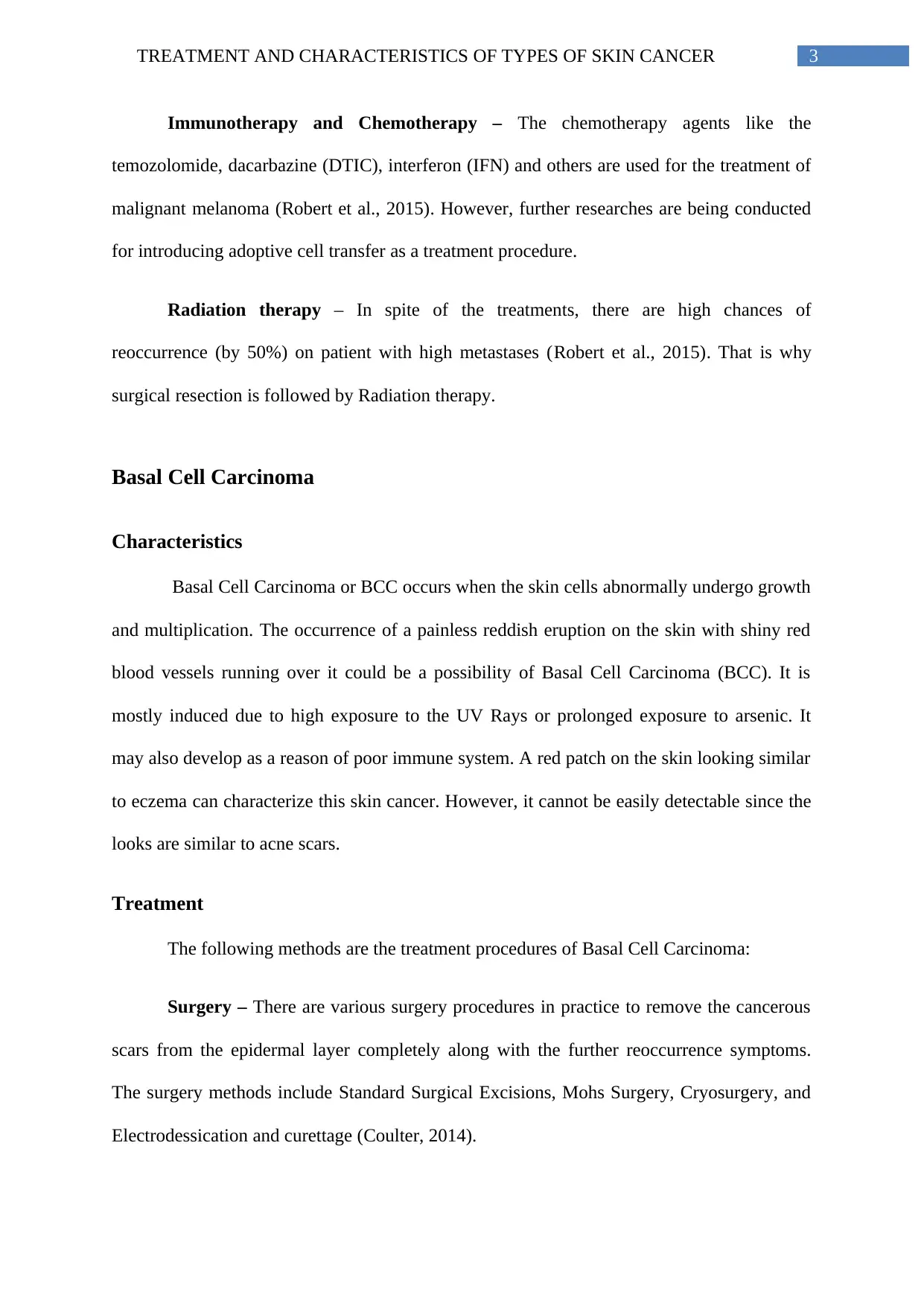
3TREATMENT AND CHARACTERISTICS OF TYPES OF SKIN CANCER
Immunotherapy and Chemotherapy – The chemotherapy agents like the
temozolomide, dacarbazine (DTIC), interferon (IFN) and others are used for the treatment of
malignant melanoma (Robert et al., 2015). However, further researches are being conducted
for introducing adoptive cell transfer as a treatment procedure.
Radiation therapy – In spite of the treatments, there are high chances of
reoccurrence (by 50%) on patient with high metastases (Robert et al., 2015). That is why
surgical resection is followed by Radiation therapy.
Basal Cell Carcinoma
Characteristics
Basal Cell Carcinoma or BCC occurs when the skin cells abnormally undergo growth
and multiplication. The occurrence of a painless reddish eruption on the skin with shiny red
blood vessels running over it could be a possibility of Basal Cell Carcinoma (BCC). It is
mostly induced due to high exposure to the UV Rays or prolonged exposure to arsenic. It
may also develop as a reason of poor immune system. A red patch on the skin looking similar
to eczema can characterize this skin cancer. However, it cannot be easily detectable since the
looks are similar to acne scars.
Treatment
The following methods are the treatment procedures of Basal Cell Carcinoma:
Surgery – There are various surgery procedures in practice to remove the cancerous
scars from the epidermal layer completely along with the further reoccurrence symptoms.
The surgery methods include Standard Surgical Excisions, Mohs Surgery, Cryosurgery, and
Electrodessication and curettage (Coulter, 2014).
Immunotherapy and Chemotherapy – The chemotherapy agents like the
temozolomide, dacarbazine (DTIC), interferon (IFN) and others are used for the treatment of
malignant melanoma (Robert et al., 2015). However, further researches are being conducted
for introducing adoptive cell transfer as a treatment procedure.
Radiation therapy – In spite of the treatments, there are high chances of
reoccurrence (by 50%) on patient with high metastases (Robert et al., 2015). That is why
surgical resection is followed by Radiation therapy.
Basal Cell Carcinoma
Characteristics
Basal Cell Carcinoma or BCC occurs when the skin cells abnormally undergo growth
and multiplication. The occurrence of a painless reddish eruption on the skin with shiny red
blood vessels running over it could be a possibility of Basal Cell Carcinoma (BCC). It is
mostly induced due to high exposure to the UV Rays or prolonged exposure to arsenic. It
may also develop as a reason of poor immune system. A red patch on the skin looking similar
to eczema can characterize this skin cancer. However, it cannot be easily detectable since the
looks are similar to acne scars.
Treatment
The following methods are the treatment procedures of Basal Cell Carcinoma:
Surgery – There are various surgery procedures in practice to remove the cancerous
scars from the epidermal layer completely along with the further reoccurrence symptoms.
The surgery methods include Standard Surgical Excisions, Mohs Surgery, Cryosurgery, and
Electrodessication and curettage (Coulter, 2014).
Paraphrase This Document
Need a fresh take? Get an instant paraphrase of this document with our AI Paraphraser
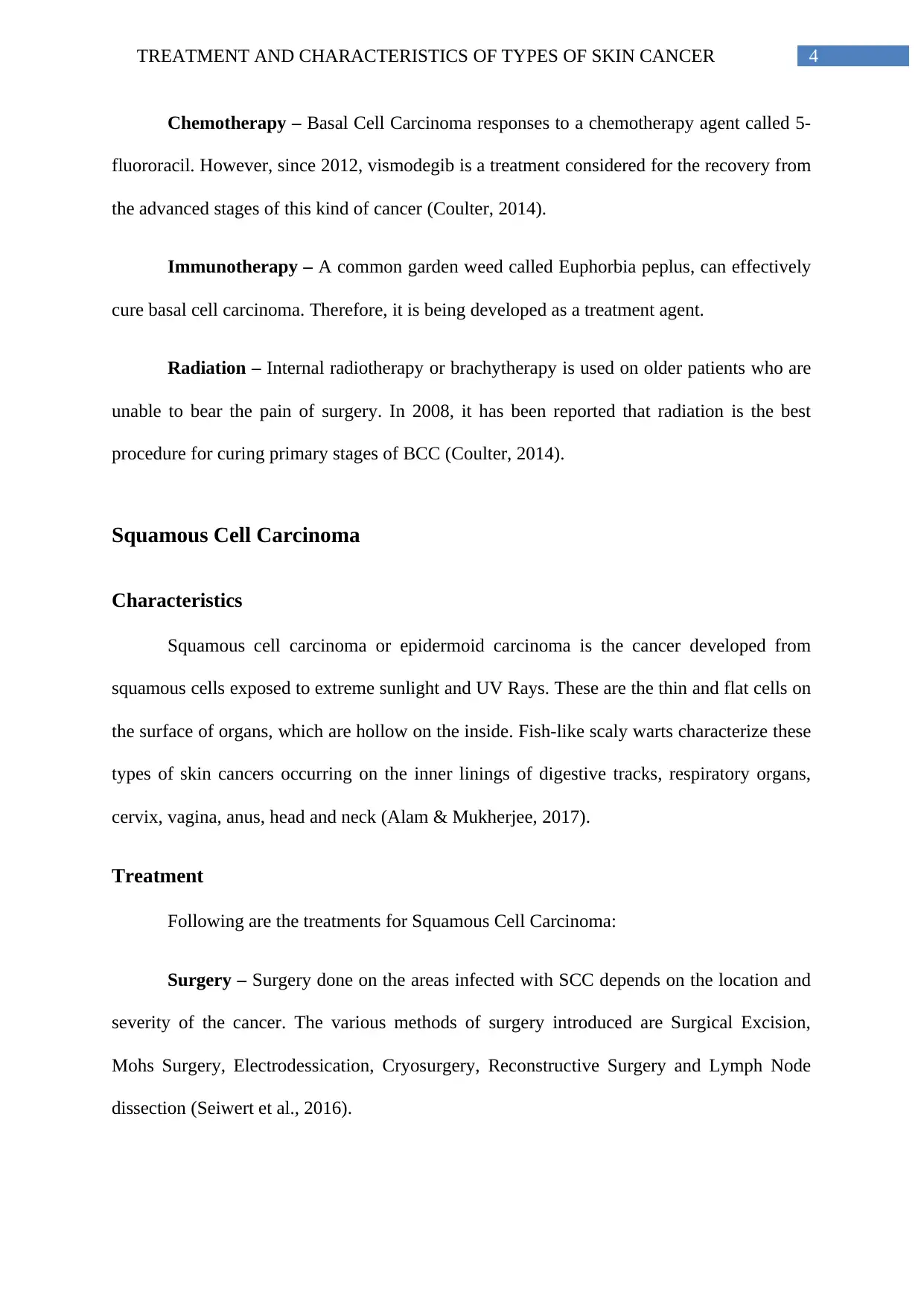
4TREATMENT AND CHARACTERISTICS OF TYPES OF SKIN CANCER
Chemotherapy – Basal Cell Carcinoma responses to a chemotherapy agent called 5-
fluororacil. However, since 2012, vismodegib is a treatment considered for the recovery from
the advanced stages of this kind of cancer (Coulter, 2014).
Immunotherapy – A common garden weed called Euphorbia peplus, can effectively
cure basal cell carcinoma. Therefore, it is being developed as a treatment agent.
Radiation – Internal radiotherapy or brachytherapy is used on older patients who are
unable to bear the pain of surgery. In 2008, it has been reported that radiation is the best
procedure for curing primary stages of BCC (Coulter, 2014).
Squamous Cell Carcinoma
Characteristics
Squamous cell carcinoma or epidermoid carcinoma is the cancer developed from
squamous cells exposed to extreme sunlight and UV Rays. These are the thin and flat cells on
the surface of organs, which are hollow on the inside. Fish-like scaly warts characterize these
types of skin cancers occurring on the inner linings of digestive tracks, respiratory organs,
cervix, vagina, anus, head and neck (Alam & Mukherjee, 2017).
Treatment
Following are the treatments for Squamous Cell Carcinoma:
Surgery – Surgery done on the areas infected with SCC depends on the location and
severity of the cancer. The various methods of surgery introduced are Surgical Excision,
Mohs Surgery, Electrodessication, Cryosurgery, Reconstructive Surgery and Lymph Node
dissection (Seiwert et al., 2016).
Chemotherapy – Basal Cell Carcinoma responses to a chemotherapy agent called 5-
fluororacil. However, since 2012, vismodegib is a treatment considered for the recovery from
the advanced stages of this kind of cancer (Coulter, 2014).
Immunotherapy – A common garden weed called Euphorbia peplus, can effectively
cure basal cell carcinoma. Therefore, it is being developed as a treatment agent.
Radiation – Internal radiotherapy or brachytherapy is used on older patients who are
unable to bear the pain of surgery. In 2008, it has been reported that radiation is the best
procedure for curing primary stages of BCC (Coulter, 2014).
Squamous Cell Carcinoma
Characteristics
Squamous cell carcinoma or epidermoid carcinoma is the cancer developed from
squamous cells exposed to extreme sunlight and UV Rays. These are the thin and flat cells on
the surface of organs, which are hollow on the inside. Fish-like scaly warts characterize these
types of skin cancers occurring on the inner linings of digestive tracks, respiratory organs,
cervix, vagina, anus, head and neck (Alam & Mukherjee, 2017).
Treatment
Following are the treatments for Squamous Cell Carcinoma:
Surgery – Surgery done on the areas infected with SCC depends on the location and
severity of the cancer. The various methods of surgery introduced are Surgical Excision,
Mohs Surgery, Electrodessication, Cryosurgery, Reconstructive Surgery and Lymph Node
dissection (Seiwert et al., 2016).
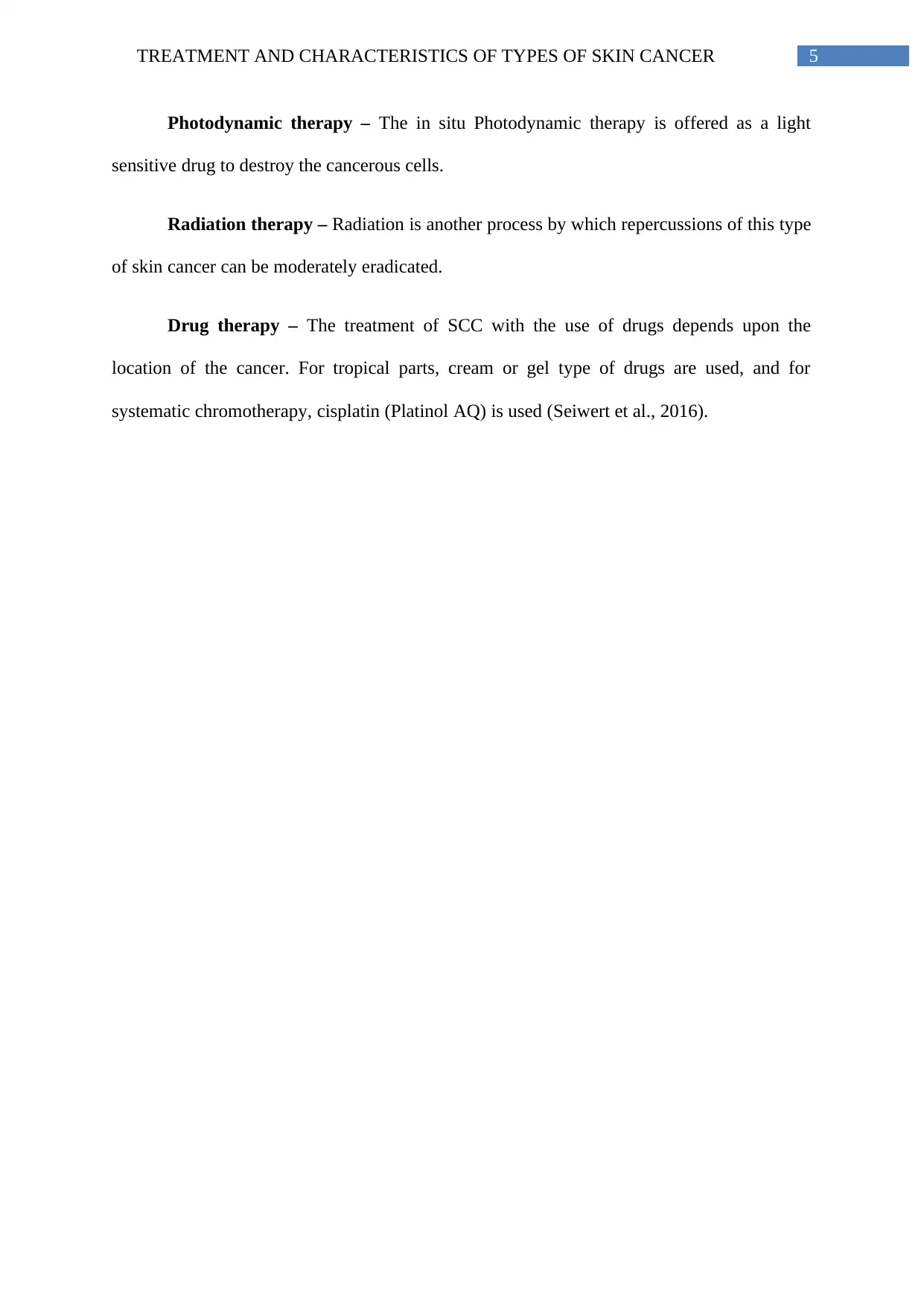
5TREATMENT AND CHARACTERISTICS OF TYPES OF SKIN CANCER
Photodynamic therapy – The in situ Photodynamic therapy is offered as a light
sensitive drug to destroy the cancerous cells.
Radiation therapy – Radiation is another process by which repercussions of this type
of skin cancer can be moderately eradicated.
Drug therapy – The treatment of SCC with the use of drugs depends upon the
location of the cancer. For tropical parts, cream or gel type of drugs are used, and for
systematic chromotherapy, cisplatin (Platinol AQ) is used (Seiwert et al., 2016).
Photodynamic therapy – The in situ Photodynamic therapy is offered as a light
sensitive drug to destroy the cancerous cells.
Radiation therapy – Radiation is another process by which repercussions of this type
of skin cancer can be moderately eradicated.
Drug therapy – The treatment of SCC with the use of drugs depends upon the
location of the cancer. For tropical parts, cream or gel type of drugs are used, and for
systematic chromotherapy, cisplatin (Platinol AQ) is used (Seiwert et al., 2016).
⊘ This is a preview!⊘
Do you want full access?
Subscribe today to unlock all pages.

Trusted by 1+ million students worldwide
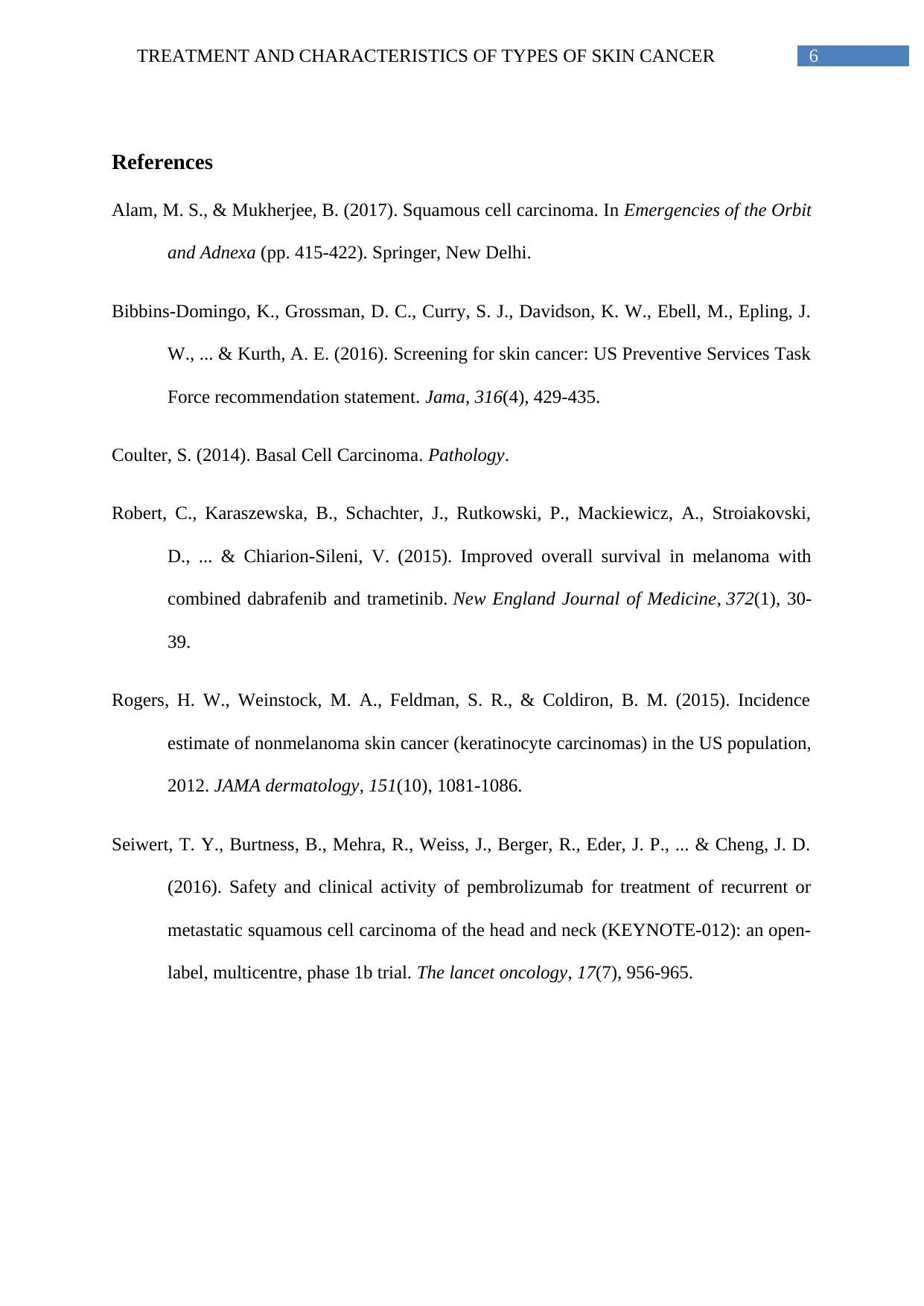
6TREATMENT AND CHARACTERISTICS OF TYPES OF SKIN CANCER
References
Alam, M. S., & Mukherjee, B. (2017). Squamous cell carcinoma. In Emergencies of the Orbit
and Adnexa (pp. 415-422). Springer, New Delhi.
Bibbins-Domingo, K., Grossman, D. C., Curry, S. J., Davidson, K. W., Ebell, M., Epling, J.
W., ... & Kurth, A. E. (2016). Screening for skin cancer: US Preventive Services Task
Force recommendation statement. Jama, 316(4), 429-435.
Coulter, S. (2014). Basal Cell Carcinoma. Pathology.
Robert, C., Karaszewska, B., Schachter, J., Rutkowski, P., Mackiewicz, A., Stroiakovski,
D., ... & Chiarion-Sileni, V. (2015). Improved overall survival in melanoma with
combined dabrafenib and trametinib. New England Journal of Medicine, 372(1), 30-
39.
Rogers, H. W., Weinstock, M. A., Feldman, S. R., & Coldiron, B. M. (2015). Incidence
estimate of nonmelanoma skin cancer (keratinocyte carcinomas) in the US population,
2012. JAMA dermatology, 151(10), 1081-1086.
Seiwert, T. Y., Burtness, B., Mehra, R., Weiss, J., Berger, R., Eder, J. P., ... & Cheng, J. D.
(2016). Safety and clinical activity of pembrolizumab for treatment of recurrent or
metastatic squamous cell carcinoma of the head and neck (KEYNOTE-012): an open-
label, multicentre, phase 1b trial. The lancet oncology, 17(7), 956-965.
References
Alam, M. S., & Mukherjee, B. (2017). Squamous cell carcinoma. In Emergencies of the Orbit
and Adnexa (pp. 415-422). Springer, New Delhi.
Bibbins-Domingo, K., Grossman, D. C., Curry, S. J., Davidson, K. W., Ebell, M., Epling, J.
W., ... & Kurth, A. E. (2016). Screening for skin cancer: US Preventive Services Task
Force recommendation statement. Jama, 316(4), 429-435.
Coulter, S. (2014). Basal Cell Carcinoma. Pathology.
Robert, C., Karaszewska, B., Schachter, J., Rutkowski, P., Mackiewicz, A., Stroiakovski,
D., ... & Chiarion-Sileni, V. (2015). Improved overall survival in melanoma with
combined dabrafenib and trametinib. New England Journal of Medicine, 372(1), 30-
39.
Rogers, H. W., Weinstock, M. A., Feldman, S. R., & Coldiron, B. M. (2015). Incidence
estimate of nonmelanoma skin cancer (keratinocyte carcinomas) in the US population,
2012. JAMA dermatology, 151(10), 1081-1086.
Seiwert, T. Y., Burtness, B., Mehra, R., Weiss, J., Berger, R., Eder, J. P., ... & Cheng, J. D.
(2016). Safety and clinical activity of pembrolizumab for treatment of recurrent or
metastatic squamous cell carcinoma of the head and neck (KEYNOTE-012): an open-
label, multicentre, phase 1b trial. The lancet oncology, 17(7), 956-965.
1 out of 7
Related Documents
Your All-in-One AI-Powered Toolkit for Academic Success.
+13062052269
info@desklib.com
Available 24*7 on WhatsApp / Email
![[object Object]](/_next/static/media/star-bottom.7253800d.svg)
Unlock your academic potential
Copyright © 2020–2025 A2Z Services. All Rights Reserved. Developed and managed by ZUCOL.




